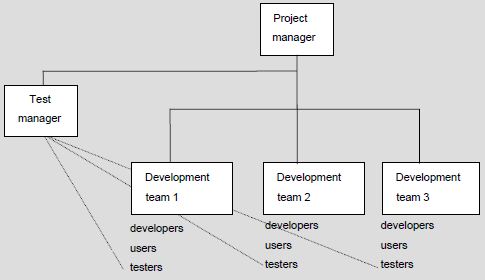Iterative and agile system development

Figure 1 : Example test management apart from teams
A disadvantage of integrated testing cited is that it can impair the independent quality assessment of the tester. A
possible solution to this is to place the test manager apart from the development teams, with the testers in these
teams answering to him. The advantage is that the gaps in the teams between developer, user and tester remain as small
as possible, while the test manager can be alerted if the testing within a team runs into difficulties through planning
pressure or other circumstances. This requires insight into the total product and project on the part of the test
manager, combined with a good political feel for the balance between ‘quality’ and ‘meeting deadlines’.
Allocating personnel
-
To have more certainty that the testers have sufficient test knowledge, one can ask for certifi ed testers. The
ISTQB (International Software Testing Qualifications Board) is responsible for an international qualification
scheme for testers (www.istqb.org). EXIN (Examination Institute
for Information Science, www.exin.com/NL/en/exams/)
organises a certification scheme specifically for TMap.
-
When people are deployed from other departments, or even other organisations, the test manager should make
allowance for agreements, procedures, selection processes, etc. This can take up a lot of time.
-
There is often external pressure to accept certain people as testers into the team. If these people are not
suitable, the test manager should be firm and spell out the consequences in terms of high training and coaching
costs and low productivity.
-
Employing or hiring in a tester cannot simply be left to a personnel or purchasing department. Good information on
this can be found in [Rothman, 2006].
Besides the suitability of the individual for the role(s), there is a further dimension: that of the team. The natural
inclination of the test manager is to select those persons whose personality most appeals to him. This can result in a
team of similar characters. The theory of team formation teaches that, in fact, it is the team with a mix of
personalities that achieves the best results. Possibly the best-known model in this area is the 9 team roles of Belbin
(see also http://www.belbin.com/). This differentiates between
functional, organisational and personal roles. The ideal composition of each team depends on the aims. Belbin
distinguishes the following roles, with a number of characteristics per role:
|
Plant
|
Creative, individualistic, imaginative, intellectual, knowledgeable
|
|
Chairperson
|
Calm, self-confident, sober, purposeful, brings out the best in every team member
|
|
Monitor/evaluator
|
Has strategic insight, is sober, unemotional, analytical and critical
|
|
Implementer
|
Conscientious, conservative, converts decisions into tasks, practical, self-disciplined
|
|
Finisher
|
Painstaking, concerned, works behind the scenes
|
|
Resource Investigator
|
Extrovert, seeks out new possibilities, enthusiastic, communicative
|
|
Shaper
|
Dynamic, energetic, extrovert, impatient
|
|
Team worker
|
Sociable, co-operative, listens well, encourages and integrates
|
|
Specialist
|
Professional, solo player, dedicated
|
For broader theory on this, refer to [Belbin, 2003]. A translation into the best test-team composition is provided [Roden,
2005].
|
